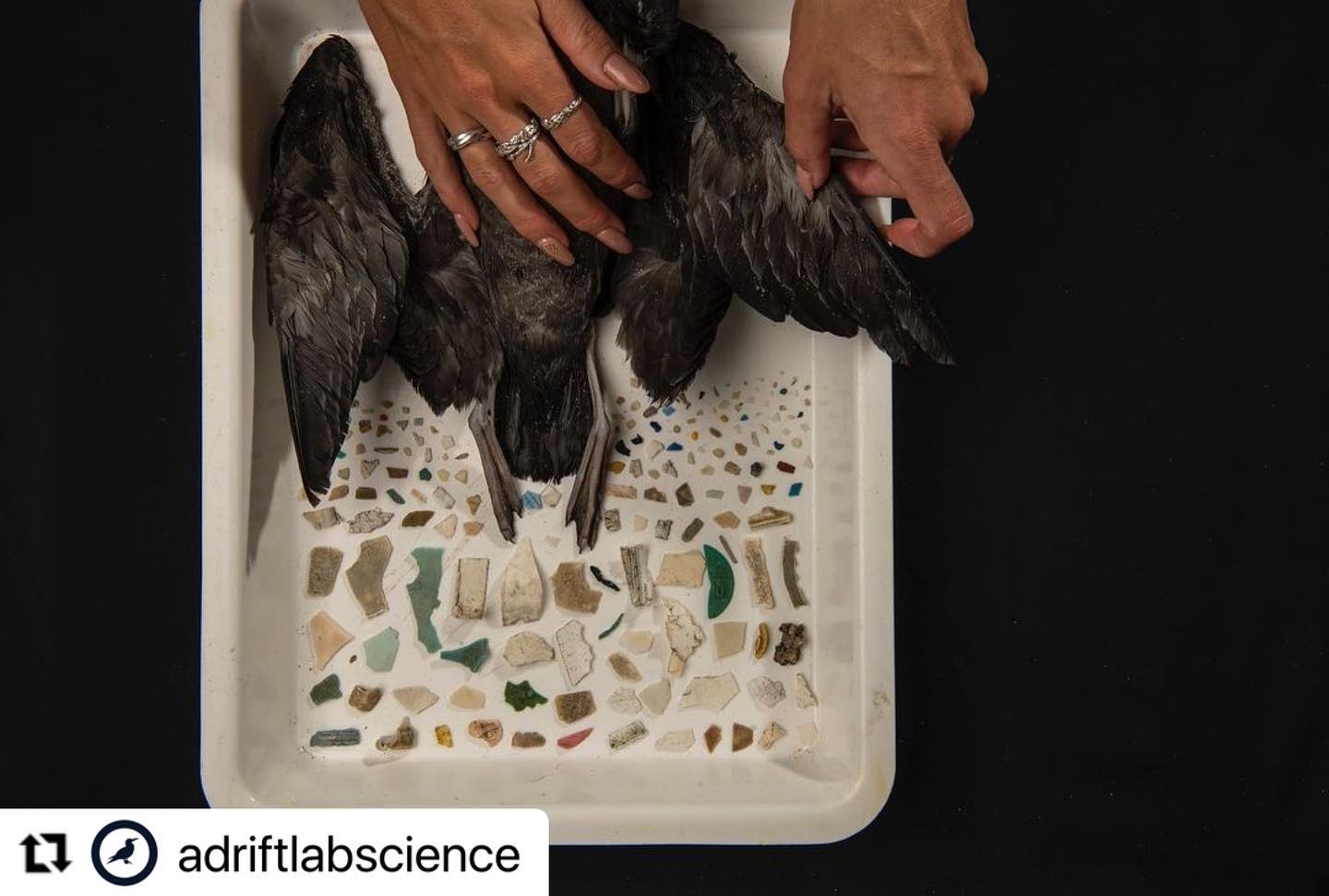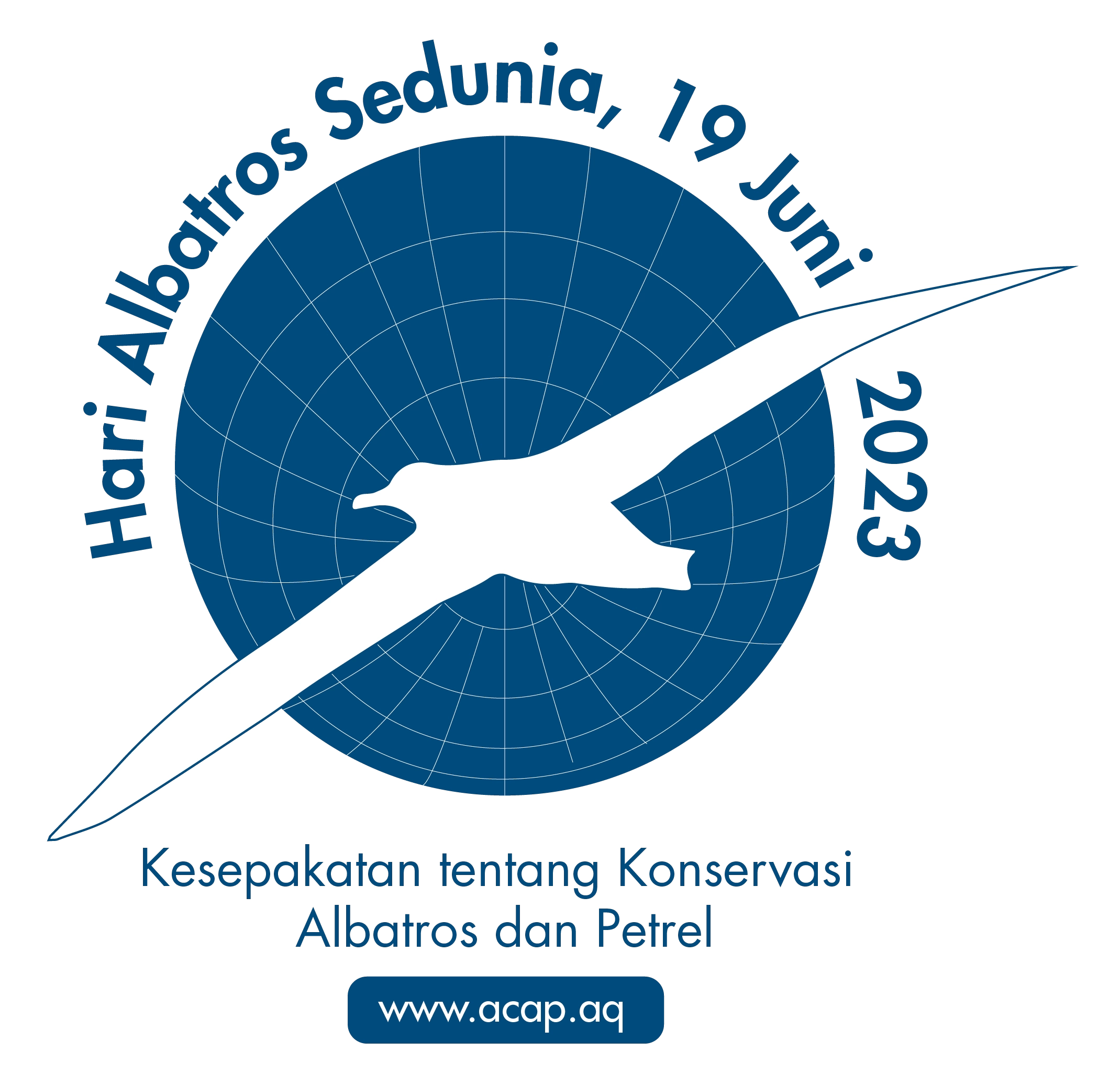
A Laysan Albatross feeds brightly coloured pieces of plastic mistakenly ingested at sea to its chick by ABUN artist Lyn Lynch, after a photograph by Chris Jordan
The Agreement on the Conservation of Albatrosses and Petrels (ACAP) has chosen the theme “Plastic Pollution” to mark the fourth World Albatross Day, being celebrated today, 19 June. The annual celebration occurs on the date the Agreement was signed in 2001. It aims to increase awareness of the continuing conservation crisis faced by ACAP’s 31 listed species of albatrosses, petrels and shearwaters.
Albatrosses are affected by a range of pollutants, of which plastics, whether ingested and then fed to chicks or causing entanglements, are certainly the most visible and well known to the general public. Albatrosses and petrels face other significant pollutants, including heavy metals, (such as mercury) and POPs (persistent organic pollutants, such as insecticides).
Dr Mike Double, Chair of the ACAP Advisory Committee, writes to ACAP Latest News: “Although bycatch in fisheries and invasive species at breeding sites remain the biggest threats, the impacts of the vast amount of plastic debris in our oceans surely contributes to the conservation crisis facing albatross species by damaging the digestive tract and likely reducing foraging efficiency, contributing to lethal or sublethal impacts. Impacts of plastic debris are particularly severe in the albatrosses of the North Pacific where almost all chicks will ingest plastics in the food provided by their parents. However, in the southern hemisphere the amount of plastic debris is increasing and plastic is now commonly detected in the stomachs of beach-cast albatrosses.”

Plastic pieces removed from the stomach of a single Flesh-footed Shearwater Ardenna carneipes that failed to fledge, photograph from the Adrift Lab
As well as the world’s 22 species of albatrosses, other procellariforms are prone to ingest pieces of plastic found floating on the sea surface and mistaken for food. A notable example is the Flesh-footed Shearwater Ardenna carnepeis, shown to ingest very large amounts of plastic at one breeding locality at least (click here), with a new term “Plasticosis” coined to describe the damage caused. This shearwater has previously been identified as a potential candidate for ACAP listing (click here).

A new initiative for 2013: The World Albatross Day logo in Indonesian
Once more, ACAP’s World Albatross Day logo has been produced in the three official ACAP languages of English, French and Spanish, plus Portuguese. In addition, and for the first year, the logo has also been produced in Indonesian, Japanese, Korean and Simplified and Traditional Chinese versions to mark the importance of Asian high-seas fishing fleets in working towards the conservation of albatrosses, petrels and shearwaters.

“Not My Little Pony”. A Northern Royal Albatross chick at Pukekura/Taiaroa Head, New Zealand avoids ingesting plastic (click here)
Two albatross species are being used to highlight the theme for this year’s World Albatross Day. These are the globally Endangered Northern Royal Albatross D. sanfordi, endemic to New Zealand, and the abundant and widespread Black-browed Albatross Thalassarche melanophris. In addition, coverage has been given once more to last year’s two featured species, the Black-footed Phoebastria nigripes and Laysan P. immutabilis Albatrosses of the North Pacific, which ingest more plastic than do the southern hemisphere species.

75 artworks from Artists & Biologists Unite for Nature have been combined in a collage in support of World Albatross Day 2023
ACAP has collaborated for the fourth year with Artists & Biologists Unite for Nature (ABUN) to produce 75 artworks by 31 participating artists that depict the effects of plastic pollution on the four featured albatross species for WAD2023. All these artworks have been combined with original music to produce a video to mark this year’s World Albatross Day; the individual artworks are also available in an ACAP Facebook Album. Six of these artworks by different ABUN artists have been made into posters in English, French, Portuguese and Spanish.

WAD2023’s 12 photo posters are also in Portuguese this year. A colour-banded Black-browed Albatross stands over its chick on Bird Island in the South Atlantic. Photograph by Erin Taylor, poster design by Bree Forrer
Twelve posters depicting the four featured albatrosses in all the nine language versions named above have been produced using photographs donated to ACAP by supporters, available from the ACAP website here and in albums in each language on Facebook.

The ACAP Species Infographic poster for the Black-browed Albatross in support of World Albatross Day 2023 has been sponsored by the Australian Antarctic Program; it is available in four language versions and three sizes
In addition, two new ACAP Species Infographics by illustrator Namasri Niumim have been created in the three official languages for the Black-browed and Northern Royal Albatrosses to mark WAD2023; joining those for Black-footed and Laysan Albatrosses that were produced last year for WAD2022. The infographic for the Black-browed Albatross also comes in a Portuguese version, marking that the species is a regular non-breeding visitor to Brazilian waters. All 12 infographics produced to date can be downloaded from here.
The logos, artwork and photo posters and the infographics are all freely available for non-commercial use in the support of the conservation of albatrosses, petrels and shearwaters. Parties to the Agreement, government environmental departments, educational facilities, NGOs and members the interested public are encouraged to print out and display ACAP’s artwork, infographic and photo posters that have been produced to mark this year’s World Albatross Day.
The Agreement on the Conservation of Albatrosses and Petrels strives, through its 13 Parties, to conserve albatrosses and petrels by coordinating international activities to mitigate threats to their populations. In 2019 ACAP’s Advisory Committee declared that a conservation crisis continues to be faced by its 31 listed species, with thousands of albatrosses, petrels and shearwaters dying every year because of fisheries operations. Raising awareness of this crisis via World Albatross Day is one-way ACAP is addressing the birds’ plight. Previous themes for World Albatross Day were “Eradicating Island Pests” in 2020, “Ensuring Albatross-friendly Fisheries” in 2021 and “Climate Change” last year.
John Cooper, Emeritus Information Officer, Agreement on the Conservation of Albatrosses and Petrels, 19 June 2023

 English
English  Français
Français  Español
Español